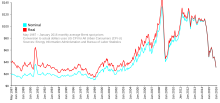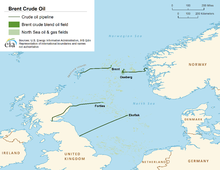Brent (oil)
Brent is the most important type of crude oil for Europe . Brent Blend is actually traded , originally a mix, mainly from the Brent and Ninian fields . Brent is a light (many low-boiling and therefore more valuable components), "sweet" (low sulfur content ) crude oil. It comes from the North Sea between the Shetland Islands and Norway. From there it is transported via an underwater pipeline to the Sullom Voe oil terminal on Mainland , Shetland (as is the oil from the Ninian field) and is transported further by tanker . Before the pipeline and the oil terminal were completed, the oil in the North Sea was loaded onto tankers from loading islands such as the Brent Spar . It is traded in London on the ICE Futures commodity exchange (formerly "International Petroleum Exchange").
The two oil fields Brent and Ninian have meanwhile exceeded their maximum production ( peak oil ). Therefore, the variety is now made up of the oil from four fields (Brent, Forties, Oseberg and Ekofisk ), since the Brent oil field itself only produces around 170,000 barrels per day, which is based on a worldwide consumption of around 87 million barrels . Barrel daily only corresponds to about 0.2%. The Brent field borders the Norwegian Statfjord field in the east, and there is a transfer pipeline between the two fields.
The Brent oil field is operated by Shell UK Ltd. and Esso Exploration & Production UK Ltd. developed, discovered it was in 1971, has been promoted since 1976, in the subfield "Brent South" since August 1992. Funded example, were in 1999 4.53 million tons in 2000, 3.533 million tons.
The most important type of oil for America is West Texas Intermediate (WTI), in Asia Dubai Fateh dominates the market. Other reference oil types are Light Sour Blend (LSB) , Leona , Tijuana , Alaska North Slope , Zuetina or Urals .
Individual evidence
- ↑ North Sea Forties Weakens After Loadings Increase for February , article on bloomberg.com of January 10, 2011

